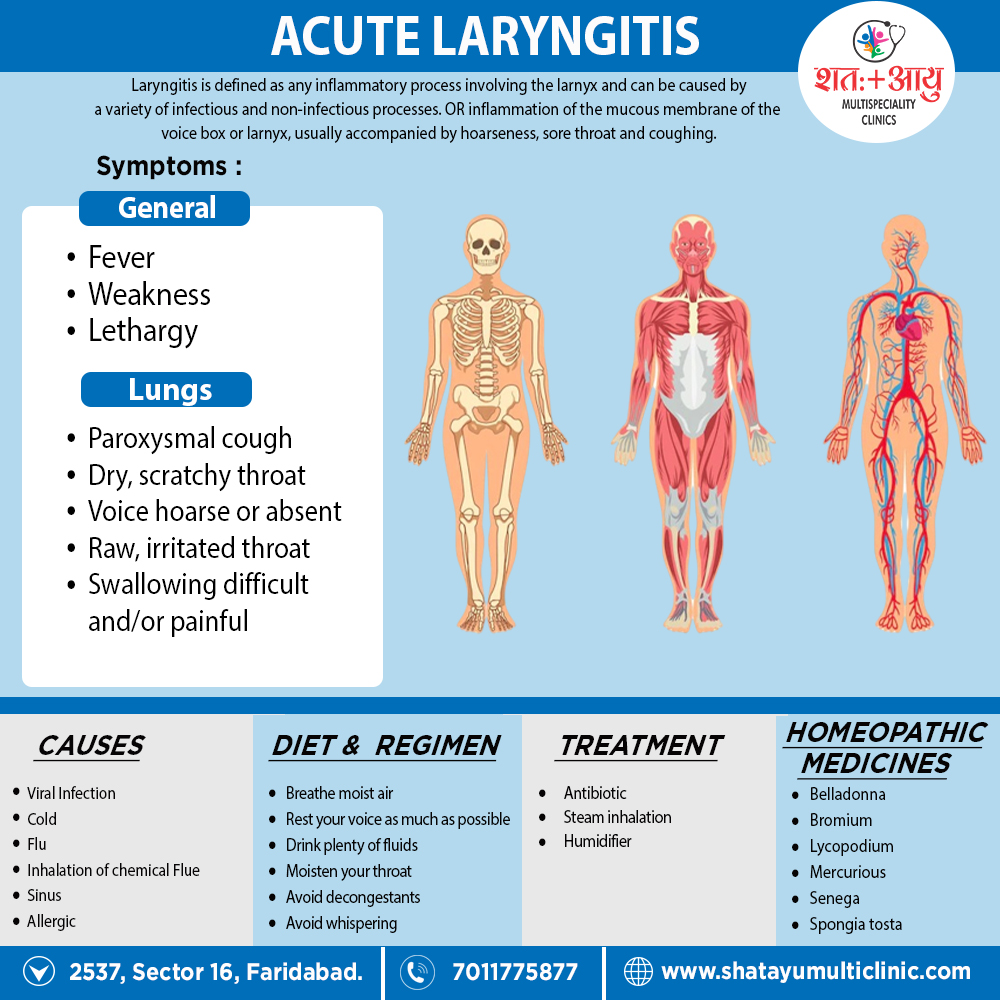Homeopathic Treatment of Acute laryngitis
Homeopathy treats the person as a whole. It means that homeopathic treatment focuses on the patient as a person, as well as his pathological condition. The homeopathic medicines selected after a full individualizing examination and case-analysis.
Which includes
- The medical history of the patient,
- Physical and mental constitution,
- Family history,
- Presenting symptoms,
- Underlying pathology,
- Possible causative factors etc.
A miasmatic tendency (predisposition/susceptibility) also often taken into account for the treatment of chronic conditions.
What Homoeopathic doctors do?
A homeopathy doctor tries to treat more than just the presenting symptoms. The focus is usually on what caused the disease condition? Why ‘this patient’ is sick ‘this way’?
The disease diagnosis is important but in homeopathy, the cause of disease not just probed to the level of bacteria and viruses. Other factors like mental, emotional and physical stress that could predispose a person to illness also looked for. Now a days, even modern medicine also considers a large number of diseases as psychosomatic. The correct homeopathy remedy tries to correct this disease predisposition.
The focus is not on curing the disease but to cure the person who is sick, to restore the health. If a disease pathology not very advanced, homeopathy remedies do give a hope for cure but even in incurable cases, the quality of life can greatly improve with homeopathic medicines.
Homeopathic Medicines
The homeopathic remedies (medicines) given below indicate the therapeutic affinity but this is not a complete and definite guide to the homeopathy treatment of this condition. The symptoms listed against each homeopathic remedy may not be directly related to this disease because in homeopathy general symptoms and constitutional indications also taken into account for selecting a remedy, potency and repetition of dose by Homeopathic doctor.
So, here we describe homeopathic medicine only for reference and education purpose. Do not take medicines without consulting registered homeopathic doctor (BHMS or M.D. Homeopath).
BELLADONNA:
Dry throat. Esophagus feels dry, constricted. Scraping sensation. Tickling, short dry cough, < night. Larynx feels sore. Painless hoarseness. Barking cough, whooping cough. Hoarse, loss of voice. In addition, Larynx feels very painful – as if a foreign body were in it, with cough.
BROMIUM:
Throat feels raw, evening, with hoarseness. Tickling in trachea during inspiration. Hoarseness coming on from overheated. Spasmodic cough with rattling of mucous in larynx. Worse – from evening until midnight, warm damp weather. Better – from motion.
IODUM:
Laryngitis with painful roughness. Worse during cough. Child grasps throat when coughing. Dry morning cough from tickling in larynx. Hoarse.
Worse – indoors, warm, wet weather, when lying on back. [2]
MERCURIUS:
Throat, red, swollen, painful. Intensely inflamed. Swallowing painful. Pain in larynx, as if cut with knife. Aphonia (loss of voice). Cough with bloody expectoration. Salivation++. Worse – slight external pressure, evenings, also at night.
NITRIC ACID:
Hoarseness. Aphonia, with dry hacking cough specifically from tickling in larynx and pit of stomach. Soreness at lower end of sternum. Cough during sleep.
Worse – evening also night, cold climate and also hot weather. On the other hand, Better by while riding in carriage.
PHOSPHORUS:
Larynx very painful. Clergyman’s sore throat. Violent tickling in larynx while speaking. Aphonia worse evenings. Cannot talk due to pain in larynx. Hard, dry, tight, racking cough. Sputa rusty, blood coloured or purulent. Worse – cold air, laughing, talking, evening, especially lying on left side.
SENEGA:
Hoarseness, hurts to talk, loss of voice, bursting pain-in back on coughing. Catarrh of larynx. Moreover, Cough often ends in a sneeze. Voice unsteady, vocal cords partially paralysed.
Worse – walking in open air, during rest. Additionally, Better – sweat, bending head backwards.
SPONGIA TOSTA:
Cough, dry, barking, also croupy. Larynx sensitive to touch. Furthermore, Respiration short, panting, difficulty, feeling of a plug in larynx, laryngeal phthisis (wasting away).
Worse – before midnight, cold air, wind, ascending. Better – warm drink, descending, lying with head low. [2]

